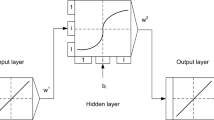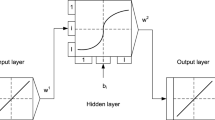Abstract
The essential characteristic of artificial neural networks which against the logistic traditional systems is a data-based approach and has led a number of higher education scholars to investigate its efficacy, during the past few decades. The aim of this paper was concerned with the application of neural networks to approximate series solutions of a class of initial value ordinary differential equations of fractional orders, over a bounded domain. The proposed technique uses a suitable truncated power series of the solution function and transforms the original differential equation in a minimization problem. Then, the minimization problem is solved using an accurate neural network model to compute the parameters with high accuracy. Numerical results are given to validate the iterative method.







Similar content being viewed by others
Explore related subjects
Discover the latest articles and news from researchers in related subjects, suggested using machine learning.References
Baleanu D, Diethelm K, Scalas E, Trujillo JJ (2012) Fractional calculus models and numerical methods. Series on complexity, nonlinearity and chaos, World Scientific, Boston
Bandyopadhyay B, Kamal S (2015) Stabilization and control of fractional order systems: a sliding mode approach, vol 317. Springer, Switzerland
Ervin VJ, Roop JP (2005) Variational formulation for the stationary fractional advection dispersion equation. Numer Methods Partial Differ Equ 22:558–576
Gejji VD, Jafari H (2007) Solving a multi-order fractional differential equation. Appl Math Comput 189:541–548
Graupe D (2007) Principles of artificial neural networks, 2nd edn. World Scientific Publishing, Singapore
Hanss M (2005) Applied Fuzzy arithmetic: an introduction with engineering applications. Springer, Berlin
Hassoun MH (1995) Fundamentals of artificial neural networks. MIT Press, Cambridge
He JH, Shou DH (2007) Application of parameter-expanding method to strongly nonlinear oscillators. Int J Nonlinear Sci Numer Simul 8:121–124
Jumarie G (2006) Modified Riemann–Liouville derivative and fractional Taylor series of nondifferentiable functions further results. Comput Math Appl 51:969–987
Kilbas AA, Srivastava HM, Trujillo JJ (2006) Theory and applications of fractional differential equations. In: Jan Van Mill (ed) North-Holland mathematics studies, vol 204, Elsevier, Netherland
Lakshmikantham V, Leela S, Vasundhara Devi J (2009) Theory of fractional dynamic systems. Cambridge University Press, Cambridge
Momani S, Odibat Z (2007) Numerical comparison of methods for solving linear differential equations of fractional order. Chaos Solitons Fractals 31(5):1248–1255
Momani S, Odibat Z (2007) Comparison between homotopy perturbation method and the variational iteration method for linear fractional partial differential equations. Comput Math Appl. doi:10.1016/j.camwa.2006.12.037
Odibat Z, Momani S (2006) Application of variational iteration method to nonlinear differential equations of fractional order. Int J Nonlinear Sci Numer Simul 7(1):15–27
Sabatier J, Agrawal OP, Machado JAT (eds) (2007) Advances in fractional calculus: theoretical developments and applications in physics and engineering. Springer, Dordrecht
Sweilam NH, Khader MM, Al-Bar RF (2007) Numerical studies for a multi-order fractional differential equation. Phys Lett A 371:26–33
Wang Y, Fan Q (2012) The second kind Chebyshev wavelet method for solving fractional differential equations. Appl Math Comput 218:8592–8601
Yang XJ (2012) Advanced local fractional calculus and its applications. World Science Publisher, New York
Yildirim A, Kocak H (2009) Homotopy perturbation method for solving the space-time fractional advection-dispersion equation. Adv Water Resour 32:1711–1716
Author information
Authors and Affiliations
Corresponding author
Rights and permissions
About this article
Cite this article
Jafarian, A., Mokhtarpour, M. & Baleanu, D. Artificial neural network approach for a class of fractional ordinary differential equation. Neural Comput & Applic 28, 765–773 (2017). https://doi.org/10.1007/s00521-015-2104-8
Received:
Accepted:
Published:
Issue Date:
DOI: https://doi.org/10.1007/s00521-015-2104-8




